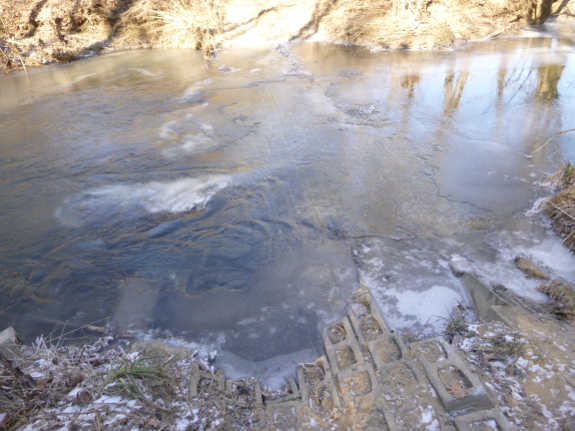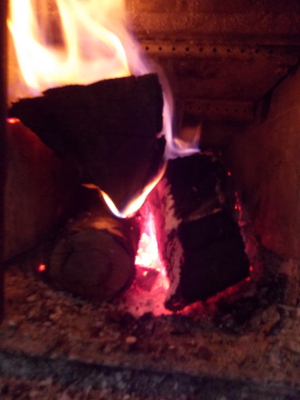
Even colder night

It only got one degree colder this time around than during the previous cold spell,
but the outside world seems to have hit another level of frozen. I
think the issue is that the ground never thawed (in most places) from
last time, so we were starting out at a considerably colder point.
I barely managed to keep the trailer above freezing overnight, and the
creek (as you'll see in the next photo) actually came close to forming a
solid skim on top.

 We're settling in for the longer haul with this cold spell too. While helping our movie-star neighbor with an audition tape, we filled up jugs of drinking water, knowing our water lines probably wouldn't thaw before the four gallons we had on hand ran out.
We're settling in for the longer haul with this cold spell too. While helping our movie-star neighbor with an audition tape, we filled up jugs of drinking water, knowing our water lines probably wouldn't thaw before the four gallons we had on hand ran out.
The oak firewood we've been cutting this week
turns out to be damper than I'd like, but not too much wetter than the
walnut that spent all (wet) summer in the shed. The photo to the
left shows a dry hunk of box-elder (on top, flaming), a
supposedly-seasoned hunk of walnut (smoldering, right), and a damp round
of oak. The last will burn, but only on a really hot fire, and I
wonder how much heat we use up driving off the moisture, compared to how
much heat we get back from the wood. We may decide to simply
stockpile the oak for next year and think about another solution for
late February firewood. Or maybe we'll get lucky and this cold
midwinter will give way to a warm early spring?
Want more in-depth information? Browse through our books.
Or explore more posts by date or by subject.
About us: Anna Hess and Mark Hamilton spent over a decade living self-sufficiently in the mountains of Virginia before moving north to start over from scratch in the foothills of Ohio. They've experimented with permaculture, no-till gardening, trailersteading, home-based microbusinesses and much more, writing about their adventures in both blogs and books.
Want to be notified when new comments are posted on this page? Click on the RSS button after you add a comment to subscribe to the comment feed, or simply check the box beside "email replies to me" while writing your comment.

After a warmer Sunday, I'm afraid the start of the week is going to be just as cold. After that temps should moderate for about a week.
Do you think adding a vent pipe heat-recapture fan would help with the temperature in the trailer when you are cranking up the rate of wood burning?
I am a serious procrastinator, so I have a lot of experience trying to burn damp wood. I have to say- dry trash woods (box-elder, cedar, poplar, etc..) are better than damp premium woods.
My advice is to split some of the walnut to even thinner splints and stack it in the trailer near the stove. Then use that when it gets really cold.
A considerable amount of the energy released in burning wood goes into elevating the temp of the water content, but, compared to the inherent inefficiency of an open fire, with so much heat wasted up the chimney, I bet the wet wood isn't that much worse than dry wood.
A "roaring fire" is considerably less efficient than a smaller, smoldering one. The total energy in the wood, lb for lb, is the same, but it's the calories released per unit time and the rate at which the heat is lost up the vent that's important for the efficiency of heating.
The bigger the heat reservoir- the stone in a fire place, the metal in a pot-belly stove- the more efficient the set up. Having the fire heat a water reservoir is can improve efficiency.